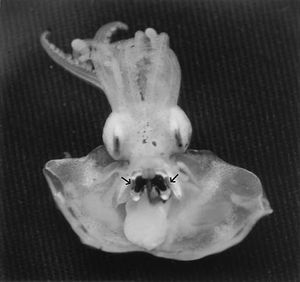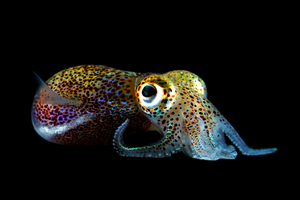Aliivibrio Fischeri and the Role of Quorum Sensing
Introduction
By Elizabeth Matteri
Aliivibrio fischeri are gram-negative Proteobacteria that are capable of producing bioluminescence. Although previously termed Vibrio fischeri, researchers proposed a reclassification of the species and changed the name in 2007 (Urbanczyk et al. 2007). The bacteria, while found throughout the ocean, colonize the light organs of specific kinds of squid and fish species. They can also be found on decaying matter in the ocean (Schaefer et al. 1996, Boettcher et al. 1990).
The most understood relationship that Aliivibrio fischeri forms is with the Hawaiian Bobtail squid (Euprymna scolopes). This squid is usually found near the shore, is nocturnal, and has two bilobed light organs on its ventral side (Wei et al. 1989). These light organs are made up of sacks, or crypts, that hold the Aliivibrio fischeri as well as two lenses and a reflector (Wei et al. 1989). This symbiotic relationship is a key predator avoidance strategy used by the squid, as the light that the bacteria emit is used to counterilluminate the squid against moonlight or starlight shining into the ocean, making them less visible to predators. In other words, the ventral side of the animal is brightened and appears more similar in color to the lighter water nearer to the surface, so a predator below the squid is less likely to notice its presence due to camouflage (Jones et al. 2004). Despite the symbiosis, it is important to note that both the bacteria and the Hawaiian Bobtail squid are capable of surviving independently of each other (Lupp et al. 2003).
Due to the many years of research that have focused on this symbiotic relationship, Aliivibrio fischeri and the Hawaiian Bobtail squid are model organisms for the ways in which bacteria can colonize a host and influence the development of a host (Visick et al. 2006). For many years, the way in which the bacteria would colonize the light organs of the squid was very poorly understood, but more recent studies are beginning to bring this process to light (Visick et al. 2006). Also, because of how the bacteria use quorum sensing as an integral part of their colonization of the host squid, Aliivibrio fischeri are a model organism used to better understand the role of quorum sensing in general, and they will hopefully lead to the development of quorum sensing inhibitor drugs in the future that can help prevent pathogenesis by other bacterial species (Visick et al. 2006). Not only this, but a quorum sensing inhibitory drug could provide an alternative form of treatment to antibiotics, as many human pathogens become drug resistant—which would help save many lives (Suga et al. 2003).



Quorum Sensing and Bioluminescence
Include some current research in each topic, with at least one figure showing data.
Section 2
Include some current research in each topic, with at least one figure showing data.
Section 3
Include some current research in each topic, with at least one figure showing data.
Conclusion
Overall paper length should be 3,000 words, with at least 3 figures.
References
[1] Boettcher, K.J., Ruby, E.G. (1990) Depressed Light Emission by Symbiotic Vibrio fischeri of the Sepiolid Squid Euprymna scolopes. Journal of Bacteriology, 172(7): 3701-3706.
[2] Centers for Disease Control and Prevention. (2014) Pseudomonas aeruginosa in Healthcare Settings. http://www.cdc.gov/hai/organisms/pseudomonas.html
[3] Jones, B. W., Nishiguchi, M. K. (2004). Counterillumination in the Hawaiian bobtail squid, Euprymna scolopes Berry (Mollusca: Cephalopoda). Marine Biology, 144: 1151-1155.
[4] Lupp, Claudia, Ruby, Edward G. (2005) Vibrio fischeri Uses Two Quorum-Sensing Systems for the Regulation of Early and Late Colonization Factors. Journal of Bacteriology, 187(11): 3620-2629.
[5] Lupp, Claudia, Urbanowski, Mark, Greenberg, E. Peter, Ruby, Edward G. (2003) The Vibrio fischeri quorum-sensing systems ain and lux sequentially induce luminescence gene expression and are important for the persistence in the squid host. Molecular Biology, 50(1): 319-331.
[6] Miller, Melissa B., Bassler, Bonnie L. (2001) Quorum Sensing in Bacteria. Annual Review of Microbiology, 55(1): 165-199.
[7] Ruby, Edward G., Lee, Kyu-Ho. (1998) The Vibrio fischeri-Euprymna scolopes Light Organ Association: Current Ecological Paradigms. Applied and Environmental Microbiology, 64(3): 805-812.
[8] Schaefer, Amy L., Hanzelka, Brian L., Eberhard, Anatol, Greenber, E. P. (1996) Quorum Sensing in Vibrio fischeri: Probing Autoinducer-LuxR Interactions with Autoinducer Analogs. American Society of Microbiology, 178(10): 2897-2901.
[9] Suga, Hiroaki, Smith, Kristina M. (2003) Molecular mechanisms of bacterial quorum sensing as a new drug target. Current Opinion in Chemical Biology, 7(5):586-591.
[10] Urbanczyk H., Ast, J.C., Higgins, M.J., Carson, J., Dunlap, P.V. (2007) Reclassification of the Vibrio fischeri, Vibrio logei, Vibrio salmonicida and Vibrio wodanis as Aliivibrio fischeri gen. nov., comb. nov., Aliivibiro logei comg. nov., Aliivibrio salmonicida comb. nov. and Aliivibrio wodanis comb. nov. International Journal of Systematic and Evolutionary Microbiology, 57(12): 2823-2829.
[11] Visick, Karen L., Foster, Jamie, Doino Judith, McFall-Ngai, Margaret, Ruby, Edward G. (2000) Vibrio fischeri lux Genes Play an Important Role in Colonization and Development of the Host Light Organ. Journal of Bacteriology, 182(16): 4578-4586.
[12] Visick, Karen L., Ruby, Edward G. (2006) Vibrio fischeri and its host: it takes two to tango. Current Opinion in Microbiology, 9(6):632-638.
[13] Wei, S.L., Young, R. E. (1989) Development of symbiotic bacterial bioluminescence in a nearshore cephalopod, Euprymna scolopes. Marine Biology, 103: 541-546.
Edited by student of Joan Slonczewski for BIOL 238 Microbiology, 2009, Kenyon College.
